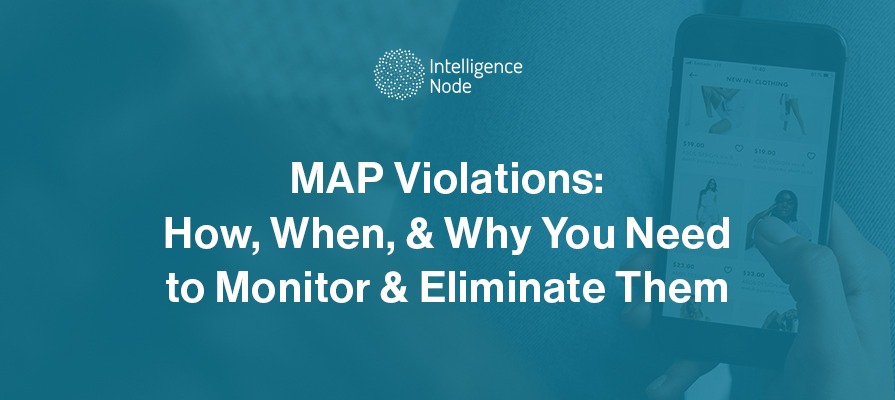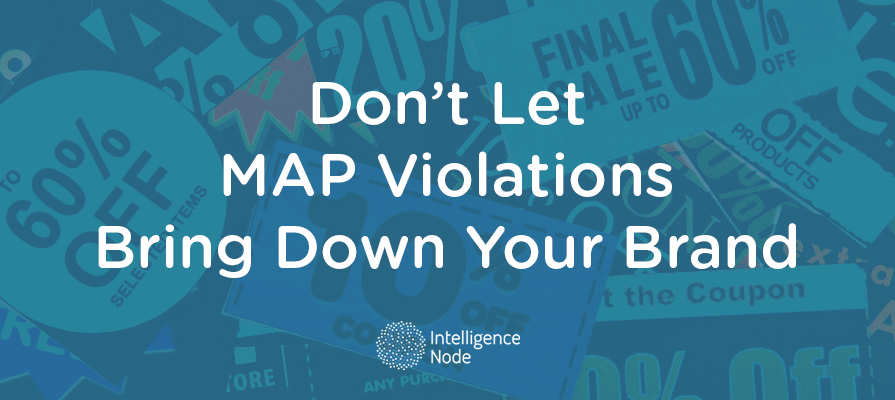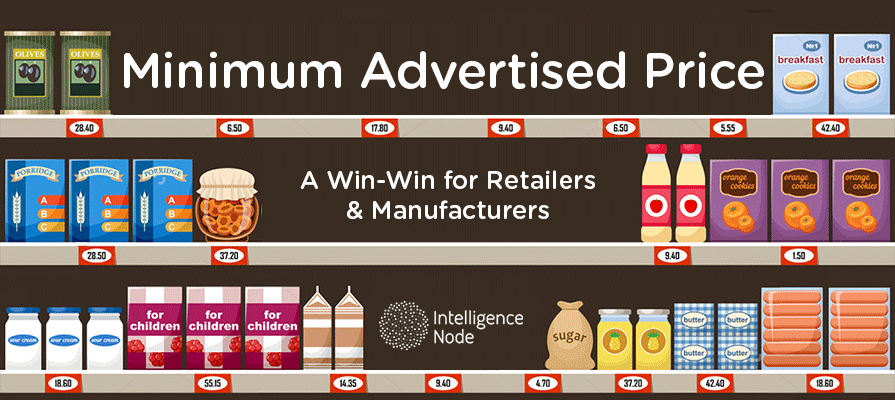eCommerce has grown tremendously in the last year and a half. While it was already on its way to mass adoption, the pandemic further accelerated the shift to digital and birthed many first-time online shoppers. The growth in eCommerce has opened many new avenues for brands and is a window into the future of retail. It has led to borderless shopping and expansion in customer base for small and large brands and retailers alike. But, on the other hand, the sudden eCommerce boost has also led to a rise in counterfeit products, unauthorized sellers, and MAP violations.
Third-party marketplaces like Amazon, Alibaba, eBay, etc, have gained a formidable market share in the last few years. In 2019, online marketplaces in the U.S. accounted for 46% of online sales and 61% of global eCommerce sales, according to a Forrester survey – and this was before the pandemic struck. As third-party marketplaces keep gaining market share, more brands and manufacturers are coaxed to sell through these platforms. And while they help improve reach and conversions, they are also turning to be breeding grounds for unauthorized sellers and counterfeiters due to lenient processes that let any distributor or seller to sell on these platforms and a lack of background checks for authenticity and authorization to sell certain products.
MAP violations hurt both brands and retailers, as, violating MAP policies leads to unfavorable market conditions and a lack of equitable distribution of sales and profitability.
Let us now look at the key reasons why retailers resort to MAP violations while selling products online:
- Lack of regulation on third-party marketplaces
- Inflexible or stringent MAP policies
- Poor MAP violations tracking
- Limited incentives for retailers to adhere to MAP policies
- Lenient or unrealistic MAP violation penalties
- Open and lax distribution networks
- No bargaining power over large retailers like Walmart & Target
In the next section, let us explore key MAP and brand compliance violation use cases and how to address them:
Unauthorized & unregistered sellers eating into your margins
A leading smart watches brand sold 12 million products last year, but only 47% of these sold units were sold by registered resellers in the Asia-Pacific region. To improve margins without affecting online sales, the brand needs to round up all unregistered sellers in the region. It then needs to penalize them or convert them to registered sellers compliant with its MAP policy.
Also Read about : Threats, Challenges, and Best Practices for Combating Counterfeit Products
With an advanced MAP monitoring solution, brands can probe into sellers worldwide to:
- Check if they are selling on other platforms unregistered
- Flag product reviews for counterfeit products and inconsistent brand experience and
- Take action against unauthorized sellers

Retailers selling below MAP on Amazon
A large sportswear brand known for its quality and durability decided to sell its products on Amazon through various sellers and distributors. Its online sales doubled in a year, Amazon largely contributing to the growth figures. But on analyzing the numbers, product margins, and profits, it noticed a disparity between the sales figures and the product margins derived from these numbers. On further probe, it noticed several MAP violations across its SKUs and a surge in counterfeit products sold under its brand name, on Amazon.
Apart from brand erosion and margin losses, this also led to a breach of customer trust and negative customer reviews owing to price inconsistencies and substandard and fake products linked to its brand.
With automated MAP enforcement, brands can:
- Monitor sellers selling their products on Amazon and other marketplaces
- Get alerted on any suspicious activity or unauthorized trade
- Get notified of MAP violations on Amazon.com, in real-time
Inaccurate brand representation on third-party websites
A Korean beauty brand entered the US online market a couple of years ago and got sweeping reviews and recognition. It saw a 100% surge in its sales and conversions in the first two years and expected to reach its retention numbers easily. But, there was very little customer retention. On doing an audit and looking at the customer reviews, the brand realized that its products were being misrepresented on third-party websites and retail sites. Missing and inaccurate descriptions, low quality images, and deep discounts were some of the reasons the brand was missing out on customer loyalty and repeat purchases.
Brands like these can use a Brand Compliance solution to preserve their reputation and service quality by:
- Enforcing brand compliance guidelines across retailer ecosystem
- Monitoring product copy and images to check for sellers and websites that are not complying with the brand policy
- Identifying inconsistent product listings and alerting retailers of the same
Best Practices to Control MAP and Brand Non-compliance
We have established why retailers sell below MAP and have discussed various MAP violation and brand non-compliance scenarios earlier in this post. It is now time to understand how to nip the MAP non-compliance problem in the bud and establish brand and price uniformity across all retail channels:
Draft & Enforce a Comprehensive MAP Price Monitoring Policy
The first step in countering MAP violations and reclaiming control of your prices is by drafting a comprehensive and fair MAP monitoring policy. A policy that aligns with both your and your retail partners’ goals. Along with MAP guidelines, your MAP policy needs to be detailed and should include specifics on marketing policies and imagery usage that will help maintain a uniform brand image across resellers. Drafting a comprehensive MAP policy is only half the battle won. Brands and manufacturers need to have stringent processes in place to enforce their MAP policy across all channels and distribution networks to reign in their partner retailers and maintain fair trade and optimum prices that benefit all.
Read more About map pricing : MAP Pricing Policy: A Must Have For Brands in Today’s Digital Age
Implement Automated, AI-driven MAP Monitoring
With product distribution spread across the globe through a network of retailers and resellers, keeping a close watch on all resellers and online channels is impossible if handled manually. Brands need to find an automated, AI-driven map monitoring solution that can track all their products sold across hundreds of websites and identify MAP violations around the clock. They need to implement an advanced solution that can act as their eyes and ears, 24×7, and alert them of any brand violations, price inconsistencies, or suspicious activity in real-time.
Identify & Take Action Against MAP Violators Immediately
Once brands identify violators, it is crucial that they penalize them to ensure there are no repeat breaches. If retailers and marketplaces have signed a MAP policy, brands have the right to move against them and even terminate their listings. If these resellers or marketplaces continue to violate MAP policies despite warnings, brands can take legal action against them. For a more effective resolution, brands should inform authorities of criminal persecution and publicly discredit the defaulted parties. This action is sure to discourage other retailers from selling your products below MAP or through unauthorized channels.
Work with Regulatory Bodies, Customs, and Trade Associations
Brands can partner with trade associations like the American Apparel and Footwear Association (AAFA), the Anti-Counterfeiting Group (ACG) or the International AntiCounterfeiting Coalition (IACC) to get assistance with spreading consciousness amongst consumers on counterfeit trade and gray market activities. These associations also carry out regulatory checks for their partner companies and can further your fight against unauthorized trade. Moreover, regulatory bodies like NAFDAC and SON can help through cleanup campaigns and market raids, as they are authorized to take legal action against counterfeiters.

With the vast inflow of cross-border counterfeit goods, partnering with the Customs office is another way to quell counterfeit trade right at its roots. You can work with Customs by registering your trademarks and helping train Customs officials in spotting fakes and first copies of your products.
Embrace DTC Channels to Eliminate MAP violations
Selling Direct to Customer (DTC) is another effective way to eliminate the problem of unauthorized sellers and MAP violations. With DTC, you can have complete control over your distribution channels, sell your products through your own eCommerce platforms, can forge better relationships with your customers, and maintain a tight control over who sells your products. Although selling through DTC channels has yet to gain mass appeal amongst brands due to the costs involved, channel conflicts, or inability to match prices, it has started to gather limelight. Infact, a lot of established and new brands like Nike, Nestle, Under Armour, Stitch Fix, BirchBox, etc. have adopted DTC successfully and many others following suit amidst the growing eCommerce demand.
Final Thoughts
eCommerce has already become indispensable to almost all brands and retailers across the globe. And as brands set out to scale their eCommerce operations and seize bigger market shares, they will no longer be able to disregard or ignore the snowballing problem of unauthorized sellers and MAP violations. The sooner brands and manufacturers come together and demand better laws, stricter punishments, and implement more sophisticated MAP monitoring solutions, the faster they will be able to control and eliminate MAP and brand non-compliance and create a fair and equitable retail ecosystem for all stakeholders.
Looking for a robust MAP monitoring solution to identify price violations around the clock? We can help!
Intelligence Node’s AI driven MAP monitoring solution is trusted by industry leaders like Nestle and Prada and finds MAP violations in real-time with 99% accuracy.





